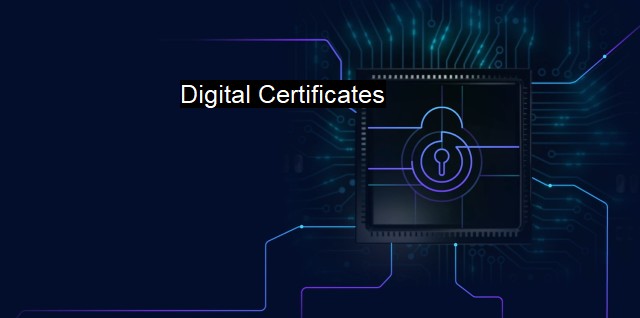What are Digital Certificates?
The Importance of Digital Certificates for Ensuring Online Security: Authentication and Encryption Explained through Public Key Cryptography
"Digital certificates" are a pillar of security in today's interconnected technological world. They are essential elements in both cybersecurity and antivirus software that act as 'passports' or 'ID cards' within the cyber universe. They facilitate trust, effectively ensuring an associate, partner, website, or software solution is credible, authentic, and safe for interaction.Technically speaking, digital certificates, also known as "public key certificates," are electronic documents verified by a Certification Authority (CA). These documents work based on cryptography and include the public key of a public-key pair. Digital certificates are used to authenticate the identity of the holder of a public key, such as a person, a device, or a server, and to prevent imposters from posing as legitimate entities.
A digital certificate traditionally comprises the owner's name and public key, the certificate validity period, the digital signature of the certificate-issuing authority, and the location of a revocation center where the certificate's status can be verified. Therefore, it does more than just ensure the holder's identity - it also provides a layer of aspects associated with the management of a user's valid, trusted relations within the cyber ecosystem.
Digital certificates are crucial since they help enhance the level of trust within the digital space, consequently reducing the possibility of cyber threats. The use of these digital certificates provides an assurance to all stakeholders that the individual or entity they are dealing with is who they claim to be. It makes one of the key differences between secure communications and potential cyber threats or attacks. Identifying each entity based on its own unique and verified digital certificate cuts out the chances of interacting with a fake or malicious entity, thus preventing data breaches and security incidents.
In antivirus software and other security applications, digital certificates are necessary to exchange data securely over a network using protocols such as SSL (Secure Socket Layer) or TLS (Transport Layer Security). it facilitates encryption to secure email services, for VPN (Virtual Private Network) connectivity, and for traditional website (HTTPS) data transmissions.
While business is increasingly conducted over digital channels, the stakes of compromising security measures are also commensurately amplified. Digital certificates help to control who gets to access or modify asset or resources of an entity. Unauthorized access could lead to data corruption, theft or even insertion of malware and ransomware attacks into the system. By ensuring secure communication and limiting access permissions, digital certificates play a crucial role in thwarting these types of threats.
Digital certificates also dictate the extent at which a person within an organization can access or transfer information internally or externally. They assist in maintaining a high level of confidentiality and integrity within the corporate communication networks, endorsing only trusted and safe exchanges.
On the downside an expired digital certificate serves no safety purpose and can diminish the security integrity. As such, constant management and renewing of these digital certificates are mandatory to uphold an optimal level of cybersecurity protection. Ensuring every interaction and communication stands on an encrypted, secured pathway could fall on the reliability of these digital certificates.
There is no overstating the importance of digital certificates to cybersecurity and antivirus protections. Their contributions to verifying identity, facilitating encryption, and maintaining trust in digital interactions are instrumental for businesses and individuals alike. They are not only an essential preventive measure against threats to cybersecurity but also a remedial tool whenever security vulnerabilities are detected.

Digital Certificates FAQs
What is a digital certificate?
A digital certificate is an electronic document that securely stores and verifies the identity of an individual or organization. It is used to facilitate secure communication over the internet by ensuring the authenticity of websites, software, and other digital resources.How do digital certificates work in cybersecurity?
Digital certificates work by creating a secure connection between a user's device and a website or other digital resource. This connection is established through a process called SSL/TLS encryption, which uses the digital certificate to verify that the website or resource is trustworthy and that the data being exchanged is secure. This helps to protect against cyberattacks and other security threats.What is the role of digital certificates in antivirus software?
Digital certificates play an important role in antivirus software by helping to identify and verify legitimate software and applications. Antivirus programs use digital certificates to validate the identity of the software publisher and ensure that the software has not been tampered with or modified in any way that could compromise security. This helps to prevent malware and other harmful programs from infecting users' devices.Are all digital certificates the same?
No, there are different types of digital certificates, each with its own level of security and authentication. Some examples include domain validated (DV) certificates, organization validated (OV) certificates, and extended validation (EV) certificates. Each type of certificate is issued by a certificate authority (CA) and provides varying levels of identity verification and encryption. It is important to choose the right type of certificate for your specific needs to ensure the highest level of security.| | A | | | B | | | C | | | D | | | E | | | F | | | G | | | H | | | I | | | J | | | K | | | L | | | M | |
| | N | | | O | | | P | | | Q | | | R | | | S | | | T | | | U | | | V | | | W | | | X | | | Y | | | Z | |
| | 1 | | | 2 | | | 3 | | | 4 | | | 7 | | | 8 | | |||||||